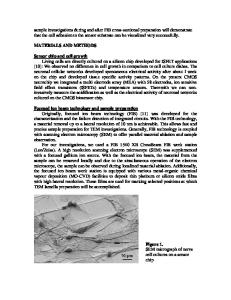Fabrication of micro-fluid-channel structures by focused ion beam techniques
- PDF / 4,131,152 Bytes
- 8 Pages / 595 x 842 pts (A4) Page_size
- 16 Downloads / 308 Views
1181-DD03-01
Fabrication of micro-fluid-channel structures by focused ion beam techniques Junichi Yanagisawa1, Hiroaki Kobayashi2, Kakunen Koreyama2, and Yoichi Akasaka2 1 School of Engineering, The University of Shiga Prefecture, 2500 Hassaka-cho, Hikone, Shiga 522-8533, Japan 2 Graduate School of Engineering Science, Osaka University, 1-3 Machikaneyama-cho, Toyonaka, Osaka 560-8531, Japan ABSTRACT One of the new applications of focused Ga ion beam (Ga FIB) techniques in the fabrication of micro-fluid-channels on plate glass was demonstrated. After discussing the features of the FIB-etched patterns, narrow or Y-shaped channels were fabricated by FIB etching on a patterned plate glass prepared by photolithography and wet etching. Micro-fluid devices were then constructed using a polydimethylsiloxane (PDMS) sheet and silicone rubber tubes, and the water (or ink) flow in the devices was observed under a microscope using a syringe pump. Although no discussion based on fluid mechanics has been carried out at present, the present results indicate the possibility of applying FIB techniques to fabricate micro-fluid devices that can be used in bio- and/or chemical-related fields. INTRODUCTION Among many microfabrication techniques developed so far, mainly in the semiconductor research and manufacture fields, photolithography using masks with fixed patterns has potential for the mass production of devices. This technique is now widely used in other fields such as bioand chemical-chip fabrication on plate glass. In bio- and chemical chips, micro-fluid channels are key structures. By photolithography and etching, the depth of the micro-fluid channels can be controlled by adjusting the etching time, therefore, the depth of patterns produced during one process is almost uniform. In other words, it is difficult to fabricate micro-fluid channels with partially different depths by conventional lithography techniques. In addition, only one chip with different kinds of patterned microchannel structures is desired in research and development stages. For such usages, photolithography may not be the best production process. Using a focused ion beam (FIB), the fabrication of microstructures in any pattern with any depth can be accomplished without using any masks. In addition, novel three-dimensional structures can also be formed by the FIB process [1]. Although the process time of FIB etching is rather long (depending on the patterning area desired), it is expected to be used in research and development fields in which only one sample chip is required. Wilhelmi et al. reported the formation of Y-shaped trench structures on Si wafer by FIB milling [2]. However, many bio- and chemical chips are formed on plate glass at present. Therefore, to apply the FIB process in producing test bio- and chemical chips, the formation of microchannels by FIB should be performed on plate glass. In the present work, the formation of microchannels on plate glass by the FIB process is performed. Although no discussion based on fluid mechanics has been condu
Data Loading...










